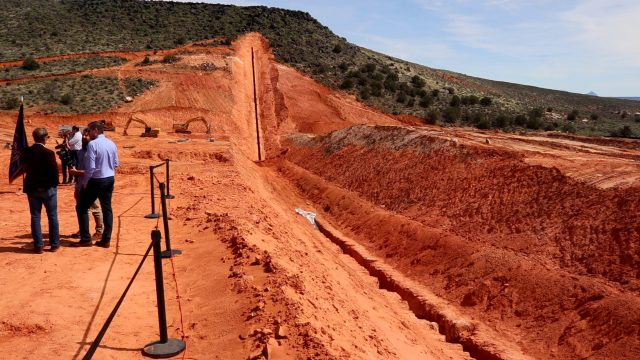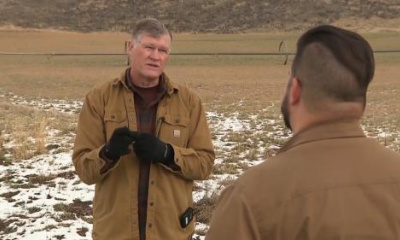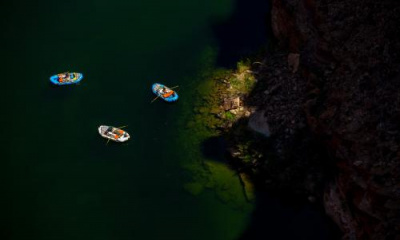ST. GEORGE — Earlier this year the Washington County Water Conservancy District received a $7 million grant from the Bureau of Reclamation for Chief Toquer Reservoir. On Tuesday, the bureau’s commissioner announced the water district as the recipient of $20.5 million in funding for its regional reuse water system project.
“Investment in water recycling and reuse are key to stretching limit water supplies (and) making systems more resilient to the effects of aridification in the American West,” Reclamation Commissioner Camille Calimlim Touton said during a press conference held at the Metropolitan Water District of Southern California on Tuesday afternoon.
Touton was in California to announce the bureau’s $179 million investment in water projects focused on drought resilience and increasing water security for communities across the West through President Joe Biden’s Investing in America agenda. Overall funding for these projects comes from the Bipartisan Infrastructure Law.
“Water recycling plays a critical role in improving sustainable water supplies,” Touton said. “It’s an innovative and cost-effective tool that can help make our water supply more reliable, helping communities find new sources to meet their needs today, but most importantly, to meet our needs in the future.”
While the bulk of the $179 million will go to water reuse and recycling projects in California, $20.5 million will go toward Washington County’s regional water reuse system.
“We are honored to receive federal funding for our Regional Reuse System,” Zach Renstrom, general manager of the Washington County Water Conservancy District, said in a statement. “This essential system will provide our communities with critical water supply reliability.”
The county’s regional water reuse system is described by the water district as a $1 billion project that will include new and expanded treatment facilities, four new reservoirs (Chief Toquer Reservoir is one of these), 60 miles of pipeline and multiple pump stations.
Renstrom attended the event in California and spoke briefly during the press conference, thanking Touton for her bipartisan approach to water issues.
“In Utah, we are working very hard,” Renstrom said. “Our governor, our legislators and even our city councils realize that we need to do better. We need to make sure we are using every drop of water wisely and that we need to be the best stewards we can of our water.”
Following news of Washington County being granted the $20.5 million, Utah Congresswoman Celeste Maloy issued a statement congratulating the water district.
“Washington County is at the forefront of water conservation to make sure our residents and economy can continue to thrive,” Maloy said. “The Regional Reuse System is exactly the kind of innovative solution to a dry climate that will help secure Southern Utah’s future. It is great to see these federal dollars going to the right place.”
The reuse system, along with other water conservation and efficient use practices, is repeatedly referred to by Renstrom as a “critical part” of the county’s future water system, particularly as the county grows beyond its current 200,000 residents.
According to the water district’s 20-year plan, the regional water reuse system is projected to produce 24,200 acre-feet of water per year by 2042.
“We expect about half of the water our communities need over the next 20 years to come from our Regional Reuse System,” Renstrom said in a statement.
Reuse water, or reclaimed water, is wastewater that has been treated to remove contaminants, making it safe for various non-potable uses such as agricultural and landscape irrigation, industrial processes, toilet flushing and environmental restoration.
By recycling wastewater, reuse water conserves freshwater supplies, supports sustainable water management and can reduce costs for large-scale water consumers. This resource can also play a crucial role in enhancing water availability and environmental stewardship, particularly in areas facing water scarcity such as Washington County, which relies primarily on the Virgin River, a tributary of the Colorado River, for its water supply.
Through the Bipartisan Infrastructure Law, the Bureau of Reclamation is investing a total of $8.3 billion over five years in water infrastructure projects, including rural water, water storage, conservation and conveyance, nature-based solutions, dam safety, water purification and reuse, and desalination. Since the Bipartisan Infrastructure Law was signed in November 2021, the bureau has announced nearly $3.5 billion for 530 projects.
On the state level, the Utah Legislature approved $500 million for water projects across the state. This included nearly $200 million for Washington County’s regional water reuse system.







